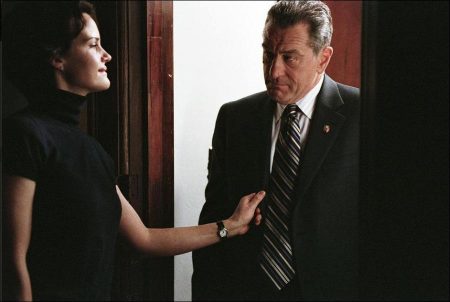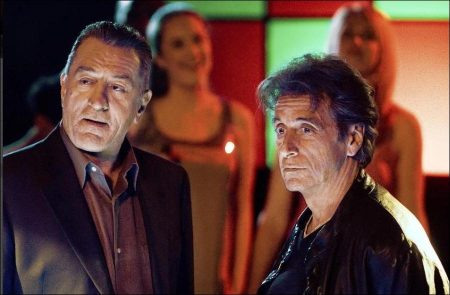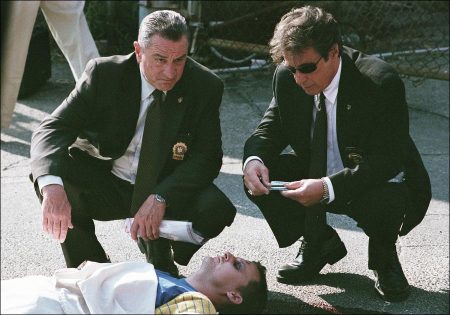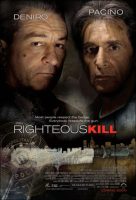Tagline: Most people respect the badge. Everybody respects the gun.
Righteous Kill movie storyline. Veteran New York City police detectives on the trail of a vigilante serial killer in the adrenaline fueled psychological thriller Righteous Kill, directed by Jon Avnet (Red Corner, Fried Green Tomatoes) and written by Russell Gewirtz (Inside Man). The cast also features hip-hop superstar Curtis “50 Cent” Jackson (Get Rich or Die Tryin’).
After 30 years as partners in the pressure cooker environment of the NYPD, highly decorated Detectives David Fisk and Thomas Cowan should be ready for retirement, but aren’t. Before they can hang up their badges, they are called in to investigate the murder of a notorious pimp, which appears to have ties to a case they solved years before.
Like the original murder, the victim is a suspected criminal whose body is found accompanied by a four line poem justifying the killing. When additional crimes take place, it becomes clear the detectives are looking for a serial killer, one who targets criminals that have fallen through the cracks of the judicial system. His mission is to do what the cops can’t do on their own — take the culprits off the streets for good. The similarities between the recent killings and their earlier case raise a nagging question: Did they put the wrong man behind bars?
Righteous Kill is a 2008 American crime thriller film with elements of a buddy cop film directed by Jon Avnet, and starring Al Pacino and Robert De Niro. This is the second film (the first one is Heat) in which De Niro and Pacino appear together in the same scenes (both De Niro and Pacino starred in The Godfather Part II, but did not appear in any of the same scenes). Righteous Kill also features John Leguizamo, Carla Gugino, Donnie Wahlberg, Brian Dennehy, and Curtis “50 Cent” Jackson. The film was released in the United States on September 12, 2008.
About the Production
Robert De Niro and Al Pacino hold a unique place in the public imagination. Known for their intensity and unforgettable performances in some of the grittiest, most respected urban dramas of the past 30 years, until now the Oscar-winning actors have shared only a few minutes of screen time. Righteous Kill marks the first time audiences will see them together in almost every scene of a movie.
“When you’re told that you can you come and work on a movie with Al Pacino and Robert De Niro, it’s very hard to say no,” says producer Rob Cowan. “These two guys are iconic. I think that for everybody it was kind of a magical thing and it drew a lot of people to the project. It was certainly terrific watching them on set.”
Daniel Rosenberg, another of the film’s producers, says he would have been excited to work with just one of the film’s great lead actors. “From a producer’s standpoint, having them together in a movie is the true definition of synergy. The whole is even greater than the sum of the two parts.”
Randall Emmett, co-chair of Emmett/Furla Films and one of the film’s producers, had been looking for a property for Robert De Niro for some time. “When Avi Lerner and I came across this script, we felt it was perfect for him. He responded to it, and then the next step was kind of backwards, because we didn’t have a director. The first name that came to us was Jon Avnet, a director we’d worked with before and respected.”
Lerner, co-chairman of Millennium / Nu Image Films and the producer of over 200 films including The Black Dahlia and Rambo, says he was impressed by the way Avnet works. “I like his efficiency. I like the fact that he’s a director and a producer from the independent world and understands the way we work. And he’s a very, very sensitive person. He knows how to show the relationship between characters.”
For his part, veteran director and producer Jon Avnet was elated to have a chance to work with De Niro, who has won two Oscars and been nominated for four others. Avnet went to New York to meet De Niro and talk with him about the script. When the conversation turned to casting, De Niro suggested Al Pacino for the role of his partner.
“You know, Al and I weren’t actually in any scenes together in Godfather 2,” says De Niro. “We did Heat about 13, 14 years ago and it was great, but we were only together for a few minutes on screen. When I said, `Well, what about Al?’ Jon just grabbed onto that.”
“Bob suggested I play the role,” recalls Pacino. “I read the script and felt it would be a good opportunity to work with Bob in a role I thought I could play.”
Speaking of working with his old friend and colleague, De Niro says: “If you know each other as long as we’ve known each other, you can draw on that background. And even if it’s a subtle sort of imperceptible thing, the comfort level is there because we have known each other so long. So interesting things kind of emerge.”
“Bob and I get along well-always have,” adds Pacino, “So we have a mutual trust which always helps. Everyone involved in the film knew immediately that Righteous Kill was becoming a once in a lifetime opportunity. “Once we knew we had them both, we all had to accept the reality of the responsibility,” says Emmett. “These are two legendary guys that the whole world looks at as the greatest actors of all time. Now we have to go make the movie.”
Screenwriter Russell Gewirtz hadn’t even considered the possibility of having two of Hollywood’s most honored actors in his second film. “I don’t think of actors when I write,” he says. “My characters have no faces, they’re not actors. They’re just who they are. In this case, what was most important to me was that the two characters had to be equally matched. You have to believe a relationship between these two, a brotherhood. And I can’t think of a better pairing than these two actors.”
Gewirtz burst onto the movie scene with his first film, Inside Man, an ingeniously plotted heist movie that was named one of the American Film Institute’s Movies of the Year for 2006. “After I finished writing Inside Man, I had this idea for a cop movie,” he says. “When I completed it, it took quite a while before it went anywhere. It wasn’t sent out to all the studios the way Inside Man had been. I didn’t get to buy that house I was looking at, and I got exposure to the long slow road of trying to get a movie made in Hollywood.
“After Inside Man hit, we got a lot of buzz and eventually the script made its way to Jon Avnet and Bob De Niro and then we had a movie,” he continues. “And then we got Al Pacino and we had an event.” Like Inside Man, Righteous Kill is packed with complicated characters, sharp dialogue and unexpected plot turns that counter audience expectations. In writing the movie, Gewirtz says he decided to begin from the end of the story and work backwards. “I came up with the twist first. When I write a script like this, I look for that one moment-generally at the end of the movie-that’s going to make people say, `What did I just see? I’ve got to watch this again.’ I had that feeling when I watched The Usual Suspects and it inspired me. That’s when I started thinking, `I wish I could do that.’”
In the world of Righteous Kill, things aren’t exactly as they appear, observes Avnet. “The storytelling is unusual. There’s a fascinating character drama at the center of the piece that has its origins in a friendship that is 30 years old. In this drama, you basically are unraveling the layers until you get to the core of the characters. What are their secrets? What are their vulnerabilities? What are their idiosyncrasies?”
Rosenberg believes these complex, fleshed-out characters make the story more compelling and emotionally resonant for audiences. “Too often the focus is on the twist in the plot instead of the characters,” says the producer. “Here, before you even get to the story, you’ve already gotten to know and love these two guys. They don’t necessarily make the right choices, but they make understandable, sympathetic choices and that’s what hooks you. Every thriller has got to have a few twists and turns, but if you don’t care about the characters then I don’t think you care about the twists”
Cowan anticipates the film will receive a lot of attention at home and abroad. “We’ve got two of the biggest stars in the world and I think people always like to see what they’re doing,” he says. “Plus, it’s a great cop thriller, and a complex psychological story. This movie is all amped up leading towards the third act and it’s a full-on rollercoaster ride trying to figure out how the person that you’ve invested all your time in is going to be able to get out of this situation.”
Producer Randall Emmett adds: “Audiences love the unknown, and they love trying to figure out what’s going to happen before it happens. We’re all like children, when we go to the movies, and we sit there, and we try to figure out is it going to be this ending, did he do it, then who did it, and that’s what attracts us all to thrillers.
“Righteous Kill definitely has a lot of great drama, great characters and De Niro and Pacino,” the producer continues. “But after the audience gets over that amazing moment of these two great actors working together, they’re going to enjoy this movie because there’s so much heart; there’s so much intensity.”
Anatomy Of A Thriller
Depicting the police work in the most realistic light possible was a priority for the filmmakers, which required assembling a team of experts to ensure authenticity.
constantly picking up the phone and calling one of these guys, even just for a line or how a guy would handle something. Neil Carter, who was a homicide detective, was very helpful in that area.”
Carter was with the NYPD for 24 years. After leaving the force, he carved out a second career as a film consultant, working on films including Inside Man, The Brave One, American Gangster and The Bourne Ultimatum. His job was to review the script and advise the director and actors on whatever questions they had regarding NYPD procedures.
Producer Daniel Rosenberg recalls: “When Detective Carter first read the script, he said to Russ, `You’ve been talking to some detectives.’ Russ spent the day convincing him the story was actually the product of his imagination. It really captures what it’s like to be a cop and that is a true testament to Russ as a writer.”
Carter says Righteous Kill accurately captures the frustration some cases engender in investigators. “You sometimes get the feeling that you’re swimming against the tide. There are cases that I worked on that went on for years. Even now that I’m retired, there’s still a case going on that I worked on for the last three years of my career. It sticks in my gut, because I really want to see this case resolved.”
The close relationship between the two lead detectives, Rooster and Turk, is also something Carter experienced first-hand. “Sometimes you spend more time with your partner on the job than you spend with your wife, your girlfriend, your boyfriend,” he says. “They may even know you better than your own family knows you. You have to trust your partner, because when you’re going through a door with somebody, you have to know that they got your back and vice versa. I know guys who have been partners for years and they’ve gone through two or three wives in that time.”
Carter also worked with the actors during gun training. “They used nine-millimeters on the range, which are standard issue for NYPD. I showed them how to hold a gun, how to do a combat stand, exactly the way we’re trained in the NYPD, and how to be prepared for a shootout. Your range training puts you in the right frame of mind for handling the gun. If it jams during a gunfight, you’ve already gone through the motions, so you’re ready.”
Armorer Ed Lighter supervised and provided weapons for Righteous Kill, which included Glock 19 9-millimeter pistols, Heckler & Koch MP5 K submachine guns and an M4, a variant of the M16 military rifle outfitted with an ultra short barrel for S.W.A.T work.
“Generally a prop man can handle small amounts of firearms,” says Lighter. “When there are a lot of weapons, that’s when they will call for an armorer on set. An armorer is specialized in two ways. They’re responsible for doing the modifications to firearms to make them shoot blanks. And that, in itself, is extremely complicated, depending upon the nature of the firearm. It can be like getting an elephant to fly.
“The next is supervising the actual use of the weapons to make sure that they are handled safely, that the actors have been instructed in their use and that technical elements are cared for so there’s no jam, because any mechanical device is subject to failure.”
Lighter says he was very impressed with Jon Avnet’s meticulous attention to safety on the set. “People have the misconception that blanks are caps of some sort, but they’re actually extremely dangerous. They have to be handled as if they were live ammunition. This director’s concern was more about getting things right safely than trying to get as much done as quickly as possible, which is really refreshing.”
While set in New York City, the film was primarily shot in and around Bridgeport, Connecticut. The 36-day shoot also included filming in Harlem, Queens and Brooklyn. Producer Rob Cowan says that the decision to shoot outside the Big Apple was primarily financial. “We looked at a couple different places to shoot, but the tax break in Connecticut was really terrific, especially for a movie of our size. The proximity to New York was great, too, because so many of our actors were based out of New York.”
The most populous city in Connecticut, Bridgeport was formerly a thriving manufacturing center with hundreds of mills and factories. The city’s traditional architecture and early 20th century urban atmosphere made it a convincing stand-in for New York. Still, “Locations had to be chosen carefully,” says Cowan. “We couldn’t always just walk in and shoot. For example, we found an old linen factory and converted the former offices into our precinct.”
Cinematographer Denis Lenoir, who previously worked with Avnet on the Golden Globe-nominated telefilm “Uprising,” (for which he won the ASC award for best cinematography) came to the set with a lot of ideas about how to recreate the claustrophobia and intensity for Righteous Kill. He put together a portfolio of movie stills for the director drawn from films set in New York, including Martin Scorsese’s Bringing Out the Dead and John Cassavetes’ The Killing of a Chinese Bookie. “This was very different from what we had done before, which is what we try to do every time,” says Lenoir. “On one hand, we wanted to do a film noir, a dark movie. But on the other hand we wanted to be naturalistic or realistic. These are two cops in Manhattan, not superheroes.”
“It is a very modern story, but by shooting in very high contrast, Denis gave it the feeling an older movie,” says Cowan. “He went for that edge.”
Lenoir’s other important consideration was making sure that the atmosphere he wanted to create didn’t obscure the actor’s faces in any way. “You have Robert De Niro and Al Pacino,” he says. “I can’t speak for other DP’s, but I don’t want to put them totally in the dark. I want to see any little thing they do with their lips, with their mouth, with their faces because that is where the story is told. So I decided that the way to give the illusion of darkness was by putting bright lights not on them but next to them.”
The director says there are two key elements to Righteous Kill that he hopes will bring audiences into the theaters. Bob and Al get to play New York City Detectives. I think they play characters that feel like a perfect fit for them. “The second thing is the rest of the cast-we’ve got Leguizamo, Donnie, Curtis, Rob, Carla. It’s a very deep group of actors. There’s a depth to the world. They complement our two stars well and hopefully create a reality that let’s Russell’s story come to life.”
Righteous Kill (2008)
Directed by: Jon Avnet
Starring: Al Pacino, Robert De Niro, 50 Cent, Carla Gugino, Donnie Wahlberg, Brian Dennehy, John Leguizamo, Dan Futterman, Trilby Glover, Rob Dyrdek, Mark Famiglietti, Melissa Leo
Screenplay by: Russell Gerwitz
Production Design by: Tracey Gallacher
Cinematography by: Denis Lenoir
Costume Design by: Debra McGuire
Film Editing by: Paul Hirsch
Set Decoration by: Kathy Lucas
Art Direction by: Christina Ann Wilson
Music by: Ed Shearmur
MPAA Rating: R violence, pervasive language, some sexuality, drug use.
Distributed by: Universal Pictures, Overture Films
Release Date: September 12, 2008
Views: 59







